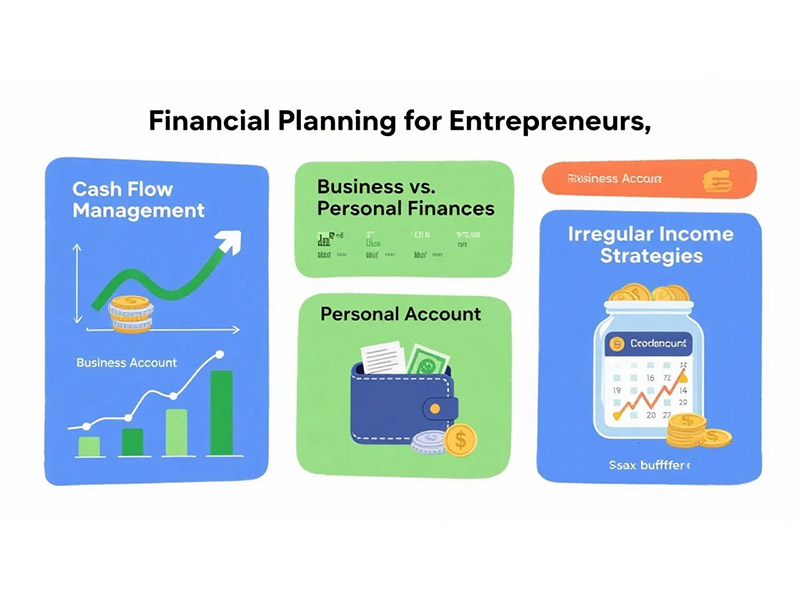Entrepreneurship carries the promise of independence, innovation, and long‑term rewards. Yet, unlike traditional employment, running a business involves a high degree of financial complexity. Entrepreneurs must not only generate revenue but also plan strategically to ensure sustainability. Sound financial planning can mean the difference between growth and stagnation. Three critical areas—cash flow management, separating business and personal finances, and strategies for coping with irregular income—are central to an entrepreneur’s financial health.
Cash Flow Management
Cash flow is the lifeblood of any business. Many otherwise viable companies fail, not because their products or services lack demand, but because of poor cash flow oversight. Entrepreneurs must understand that profits on paper are different from liquid cash in hand. A customer may sign a contract worth thousands, but if payment is delayed, operational expenses such as salaries, rent, or inventory purchases may still become due.
Effective cash flow management begins with forecasting. Entrepreneurs should prepare regular cash flow statements that map out expected inflows from sales and outflows for operating costs, taxes, and debt repayments. Visibility into upcoming shortfalls allows for proactive measures such as negotiating better payment terms with suppliers, offering incentives for faster customer payments, or arranging short‑term credit facilities.
Another vital practice is maintaining a cash reserve. A buffer fund equal to at least three months of operating expenses ensures resilience against sudden downturns in sales or unexpected expenses. Regularly monitoring accounts receivable, prioritizing timely invoicing, and automating collection reminders can also prevent unnecessary liquidity crunches. In short, successful entrepreneurs treat cash flow management as an ongoing practice rather than an occasional exercise.
Business vs. Personal Finances
One of the most common mistakes made by new entrepreneurs is the failure to separate business and personal finances. Blurring these lines creates accounting confusion, complicates tax filings, and increases the risk of mismanaging funds. Most importantly, intermingled finances obscure the true performance of the business.
The simplest step is opening a dedicated business bank account. This ensures all company revenues and expenses are distinct, allowing entrepreneurs to generate clear financial reports for decision‑making and compliance. Using business credit cards or expense tracking apps further sharpens visibility while building a credit history for the enterprise itself.
Additionally, separating finances protects personal assets. Establishing the right legal structure, such as a limited liability company (LLC), prevents personal savings from being at risk if the business encounters debt problems. Entrepreneurs should also pay themselves a fixed salary or structured draw from business earnings. This not only provides personal stability but reinforces discipline within the business budget.
By treating the business as a self‑sustaining financial entity, entrepreneurs project professionalism to lenders, investors, and partners. It also allows for better long‑term strategic planning, as the health of the enterprise becomes clearly measurable.
Strategies for Irregular Income
Entrepreneurial income is inherently unpredictable. Many startups experience seasons of feast and famine, where revenue surges during peak demand periods but slows dramatically at other times. Managing this irregularity requires both foresight and discipline.
Budgeting on a conservative baseline is a proven tactic. Instead of planning lifestyle expenses based on peak income months, entrepreneurs should establish budgets around their lowest historical income range. This approach minimizes the stress of lean months and prevents unnecessary debt accumulation.
Building multiple income streams is another powerful strategy. Entrepreneurs can diversify through complementary products, consulting services, or digital offerings that generate passive income. This diversification spreads risk and smooths earnings volatility.
Equally critical is creating an emergency fund dedicated to personal living expenses. Much like business cash reserves, a personal buffer equal to three to six months of expenses cushions entrepreneurs during periods of low revenue. Automated transfers from business income during high‑earning months can gradually grow this reserve without straining day‑to‑day operations.
Finally, tax planning plays a role in irregular income management. Entrepreneurs should set aside funds regularly for quarterly tax payments rather than scrambling during tax season. Consulting with accountants to understand deductions, credits, and optimal filing methods can significantly reduce financial strain.
Conclusion
Entrepreneurship rewards those who are visionary, persistent, and financially disciplined. Cash flow management ensures businesses survive the gaps between revenue and expense cycles. Separating business and personal finances enhances clarity, protects personal assets, and encourages long‑term growth. Finally, preparing for irregular income through conservative budgeting, diversification, and reserve funds provides stability in an unpredictable journey.
By mastering these pillars of financial planning, entrepreneurs can focus less on surviving disruptions and more on innovating, scaling, and achieving their enterprise’s true potential.



